Remember the rain in Sicily? Well it poured at Ramona's house our last night there. The street had drains but it was up over the curbs at one point when I looked out in the middle of the night. By the morning it stopped, but there still was lots of water around.
We got to the train station just fine. We had one of those movie moments with Ramona and Aidan waving "goodbye" to us and us waving from our places on the train. Our route took us the same way north as we had gone south, except only to Salerno. It was daylight so we got to see a lot that we missed in the dark before.
We left at about 9:00 am on September 24th, and were due to arrive in Salerno at about 4:00 pm. But...the rain caused a few slides across the tracks that delayed us a couple of hours before we ever got to Messina.
 The reason we wanted to get to Salerno at the time we did was so that we could take a public SITA bus from there to Sorrento along the infamous Amalfi Coast road while it was still daylight. I particularly planned the route based on when the sun was supposed to set. Best laid plans...
The reason we wanted to get to Salerno at the time we did was so that we could take a public SITA bus from there to Sorrento along the infamous Amalfi Coast road while it was still daylight. I particularly planned the route based on when the sun was supposed to set. Best laid plans...
This is one of the most fabulous drives in the world. It's usually recommended that you go from north to south (or west to east if you want to be literal about it). But that didn't suit the itinerary, and I preferred to be on the hill side of the road rather than on the water side.
We did barely manage to get on a bus at the Salerno train station. When we changed buses in Amalfi itself for the rest of the trip to Sorrento, I made Trout sit on the water side. I was so anxious that I didn't even take any pictures. I barely breathed.
This little map shows the basics of the area.

I'm sure Trout remembers this corner. When the bus got to these kinds of places, the driver would toot the horn to warn people that he was coming. This picture is from the
Seasons in Italy website. They have good links to the area and to SITA.

This is a typical view from the road. For more, search for Amalfi Coast in Google images. From what I can tell from the movie trailers for "Nine," there are some scenes shot along this road.
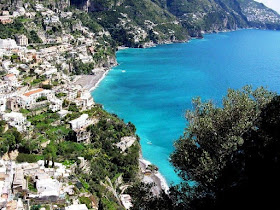
This is similar to the buses used. They aren't small even though they are truly local public transportation for the area. Fortunately, we didn't have too many situations where some idiot car driver messed things up and required that we back up. We did meet another bus and passed each other within inches.

We arrived in Sorrento after dark, and unknowingly passed up the bus stop closest to our hotel, but with the help of our bus driver, we found it and weren't lost again after that. It turned out that we were quite close to everything we needed to be close to during our stay.
We used the public buses and the
Circumvesuviana to get around town, to Pompei and back and to get to Naples for our train north. As the name implies, the Circumvesuviana is a local train specifically designed to explore the area.
Pompeii had been on my bucket list since I was a child. I've always been interested in ancient cultures. My interest only grew after taking those classics courses, especially Roman Cultural History, as an undergraduate.
Visiting it was exhausting, and I'm glad we had limited time to do it or else we would've spent all day there. We followed a
walking tour designed by Rick Steves. Most of my notes that follow are based on that. We weren't able to see everything on his list. The House of the Vetti, was closed because work was being done to it. We couldn't walk down that street because it was blocked.
Even late in the afternoon on a weekday, the brothel was so crowded, mostly with Japanese tour groups, that Trout refused to go down the street. I tried for about 5 minutes and gave up.
People were squeezing in there like they do on a subway train.
In spite of missing those landmarks, we did see a lot. Pompeii was a middle class port city of about 20,000 when the volcano blew in 79. It was rapidly covered in 30 feet of hot ash. People and animals were secured in place. That's why it was possible to fill the voids left by the deterioration of their bodies with plaster and see what they looked like. Be sure to click to the Wikipedia link above and scroll down to see the dog.
This is a popular shot across the forum past the Temple of Jupiter to Mt. Vesuvius. If you complete the triangle from the slanted sides you can get an idea of how big it was before the eruption.

The buildings were built of brick and mortar and covered with marble. It must've been an impressive site. This area was in the center of town where people met to shop and socialize. Unlike you see here, the buildings were two stories tall.


We were intrigued by the construction of the columns. This is in the basilica, or Roman court.
Later Christian basilicas were designed like this and named using the same word.

This is the top of one of the column stubs.


You can see the Gulf of Naples through the basilica. Before the eruption it was closer to Pompeii.

The streets were flooded daily to clean them. There were stepping stones across them so that people could cross over the water. You can see some toward the back of this picture. They are about the height of the sidewalk. They are high enough to keep people's feet dry, but low enough and spaced in such a way that chariots could still drive along the street with water in it. But not on this particular street. The stones in the front indicate that this is a pedestrian area.

You've probably seen these cases in pictures before. These are body casts made of some of the 20% or so of the population of Pompeii who died. They are in the market hall. The restored wall behind them is typical of the wall painting of the time.


The bones are also part of the casting with these people.


This was one of the favorite things we saw. It's a street sign that says the street is for pedestrians only. I love the practical, daily living stuff.

Trout liked watching this guy do some restoration work.

This is a dog easing out in front of a cafeteria which occupies a modernized (on the inside) building. The site is huge, so it's very good to have a place to get something to eat and drink and to have a toilet. I'm sure he gets a handout or two.

Close to the cafeteria is a men's bathing facility. These are some pictures of the interior which was very well preserved by the ash.

Here are some telemones holding up a part of the wall, sort of. They are really only decorative.

This side wall was glazed and 3-dimensional.

This is a fountain in a curved niche at the end of the room. It reminds me of the type often found in sports stadium bathrooms where a bunch of people can wash their hands at the same time.

This is the niche it's in.
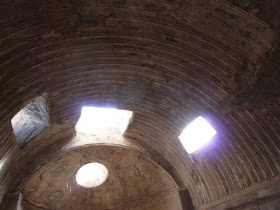
One fascinating thing about Roman life is that it was very public, especially for the middle and lower classes. Their living spaces were small with no place to cook, so they patronized public cooking facilities where they could buy food from thermos-like pots like this. There were several of these all over Pompeii.

This is an example of one of the streets with deep ruts in it from the wheels of vehicles passing over it for centuries.

This is one of the few fancier houses in the city. It has this famous "Cave Canem" (beware of dog) mosaic. Compare this dog with the plaster cast in the Wikipedia article. They are very much alike.

The dog mosaic is on the floor of the entry to this House of the Tragic Poet. This is the inside of that entry from the back.

This is a well preserved painting from an interior room of another house on down the street. It is built around two courtyards and is all very open.
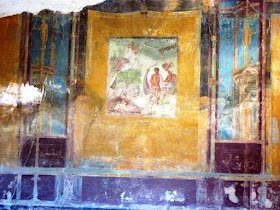
And this is just a well in that house. Notice the grooves worn into the interior of the marble from pulling a rope up and down.

This is a shot down the street. This street was apparently repaved before the blast because there are no ruts in it.

This is from the largest and one of the most famous houses in Pompeii, the House of the Faun. As with much of the art at Pompeii, the original is at the Naples Archeological Museum. We did not take the time to go there to see it. Maybe next time.

The house has more than 25 rooms and covers a city block. This is one of the floors.

This is a reconstruction of a well known mosaic, the Battle of Alexander. That would be Alexander the Great. The original is in the Naples Archeological Museum. This is a photo from the top side of the mosaic. It was the best I could do to get the whole thing in.

And this is the famous detail, found in so many art books.

In Roman terms, a house included the gardens, so this is the back of this very large house. Everything is inside walls.

In Pompeii as in most Roman cities, there was running water. These are some of the pipes for it.


This street was in very bad shape.


Similar to the fast food vendors, there were bakeries in most neighborhoods. This shows the ovens and the millstones. Grain was put in the top of the mill, the mill was turned by slave or donkey labor and flour came out the bottom. It was made into loaves and baked in ovens like the ones on the left. You can see at least 4 mills in this picture. They are very close together so only people or small animals would have room to turn them.

This shows the inside of the mill. It's pretty easy to see how the grain was ground, stone on stone. It looks like a post went in the square hole and the wooden bars that the slaves or donkeys pushed or pulled came off that post.

Around another corner we found another soup kitchen. I think I could've lived here what with other people doing the cooking.

This is a very heavily rutted one way street.

This is not the brothel. It's just an example of some of the mosaic work in one of the houses.

And these are some of the painted walls of this house.

Of course we didn't backtrack to the entrance like Rick Steves suggested. We went out the group entrance and walked along a park adjacent to the site. These are some shots of the partially excavated city from outside.



Here we are back near the entrance and the Circumvesuviana train station. This area is very big on citrus, especially lemons. In fact, Sorrento is known for its
limoncello.

Trout decided to ease out and read one of the many books he read on the trip while I bought some postcards before we left. He has his hand on a granite. It's sort of like a slushy, except with fresh fruit.

We got off the Circumvesuviana at its terminus in downtown Sorrento and decided to walk back to our hotel. On the way we stopped and made reservations at this restaurant which was highly recommended by Rick Steves.

It's on a small square with a lovely little park. I do like hibiscus.



We walked back to our hotel, rested for a bit and then walked to the restaurant though one of the narrow shopping
streets. This was the most expensive meal we had the whole trip. Trout had a really good meal and mine was only mediocre. And I thought the service was marginal. But we sat outside and it was a lovely location.



The next morning we took the Circumvesuviana to Naples and the train from Naples to Genoa. Our train mostly ran along the coast, so we got some good views of the Mediterranean. We spent only one night there, at a hotel almost on top of the train station.
We arrived late, walked down to one of the few places still open, right on the water and had some okay pizza. Then we got kind of lost walking back to our hotel, but we finally found it. I wanted to spend the night in Genoa because I remembered it being very interesting when I was there in the late 70's. This time it only seemed creepy to me -- especially as we walked back to our hotel.
These are a couple of pictures from our room. Unfortunately, I inadvertantly deleted the picture Trout really wanted of a building we could see with a big Opel sign on top.


The reason we were so close to the train station was that we were arriving late and leaving fairly early the next day. We had to change trains in Ventimiglia, so that was Trout's last chance to have gelato in Italy. He took advantage of it.


We bid "arrivederci" to Italy and headed on to France.
 So when we went to the Chagall and Miro museums in Nice, we hopped on the train for the short (less than 1/2 hour) trip each way.
So when we went to the Chagall and Miro museums in Nice, we hopped on the train for the short (less than 1/2 hour) trip each way. On Tuesday, the 29th, we went on to Carcassonne for our 3rd night in the south of France.
On Tuesday, the 29th, we went on to Carcassonne for our 3rd night in the south of France.
 Somewhere along here we had another movie moment. A woman dressed in a 60's retro cream and gold outfit dripping with gold jewelry got on the train. She had matching platinum blonde hair, was by herself and had no luggage. Rich? Prostitute? Dressed for a costume party? Who knows? My vote is for the last, but she looked like no one else we saw anywhere on any mode of transportation on our trip. We were in 1st class, but if she had any money, she'd be driving a car and if she had any real money, she'd have a chauffeur.
Somewhere along here we had another movie moment. A woman dressed in a 60's retro cream and gold outfit dripping with gold jewelry got on the train. She had matching platinum blonde hair, was by herself and had no luggage. Rich? Prostitute? Dressed for a costume party? Who knows? My vote is for the last, but she looked like no one else we saw anywhere on any mode of transportation on our trip. We were in 1st class, but if she had any money, she'd be driving a car and if she had any real money, she'd have a chauffeur. These are just a few of the boats anchored out a bit from the shore.
These are just a few of the boats anchored out a bit from the shore. Trout insisted I try to get some pictures of this Monaco train station.
Trout insisted I try to get some pictures of this Monaco train station. It was very clean and super cool.
It was very clean and super cool. I think Trout's wondering what it would be like to have the cubic money required to live here.
I think Trout's wondering what it would be like to have the cubic money required to live here. We got to Antibes just fine. We got a little confused by the directions we had to get to our hotel, but we got help from people on the street. One very nice older man with a dog that looked like Cisco put up with my bad French and helped us get to where we were going, a very inexpensive hotel in the heart of town, the Modern Hotel. It was right on a major pedestrian street, but it was very quiet. They also had the best coffee I had the entire trip.
We got to Antibes just fine. We got a little confused by the directions we had to get to our hotel, but we got help from people on the street. One very nice older man with a dog that looked like Cisco put up with my bad French and helped us get to where we were going, a very inexpensive hotel in the heart of town, the Modern Hotel. It was right on a major pedestrian street, but it was very quiet. They also had the best coffee I had the entire trip. 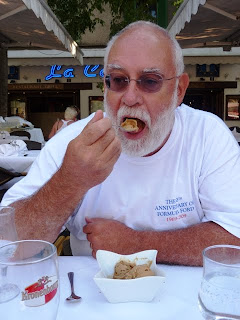 The major thing on my list for Antibes (besides just walking around) was the Picasso Museum. It's actually in an old castle of the Rainier (Grimaldi) family. Trout and I liked the building and location better than the particular work there, but I did have to pose with this piece. By the way, not all the works at the museum are by Picasso.
The major thing on my list for Antibes (besides just walking around) was the Picasso Museum. It's actually in an old castle of the Rainier (Grimaldi) family. Trout and I liked the building and location better than the particular work there, but I did have to pose with this piece. By the way, not all the works at the museum are by Picasso. And they do have prickly pear in the south of France, too.
And they do have prickly pear in the south of France, too. Incredible water.
Incredible water.
 I'm sure many of you have seen those exterior wiring pictures from India. I had to take one of this wiring outside our room.
I'm sure many of you have seen those exterior wiring pictures from India. I had to take one of this wiring outside our room.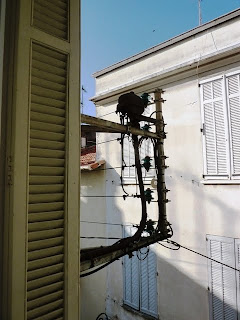 Two other things on my list for this area were to go to the Matisse and Chagall museums in Nice. So we took the train as shown above. From the train station we took a trolley to the center of town and then a bus to the museums which were along the same bus line.
Two other things on my list for this area were to go to the Matisse and Chagall museums in Nice. So we took the train as shown above. From the train station we took a trolley to the center of town and then a bus to the museums which were along the same bus line. Many places don't let you take pictures, so this was the best I could get. The same was true of the Chagall museum, but the website has some pretty good pictures of the exterior and of the works.
Many places don't let you take pictures, so this was the best I could get. The same was true of the Chagall museum, but the website has some pretty good pictures of the exterior and of the works.  We were on the Monaco train.
We were on the Monaco train.
 We got back to our room in time to rest a bit before going out to a fabulous dinner at Le Jardin.
We got back to our room in time to rest a bit before going out to a fabulous dinner at Le Jardin.




 Our room had the smallest bathroom of any on the trip. We had no AC, but it was just the right temperature to open the tops of the doors onto the garden. The one night we were there, we partially closed them. The glassed area to the right is the breakfast room. The windows at the back are into the living quarters of the owners.
Our room had the smallest bathroom of any on the trip. We had no AC, but it was just the right temperature to open the tops of the doors onto the garden. The one night we were there, we partially closed them. The glassed area to the right is the breakfast room. The windows at the back are into the living quarters of the owners. Outside the walls was this great cemetery. Except for the military cemeteries in the north of France, we saw no cemeteries like you see in the US anywhere in Europe. Land is too precious.
Outside the walls was this great cemetery. Except for the military cemeteries in the north of France, we saw no cemeteries like you see in the US anywhere in Europe. Land is too precious.
 This was the first place on the trip that we got a taxi. The distance from the train station wasn't great, but we weren't up for walking up or down any steep hills with our packs. We also splurged on a taxi from the Cite to the closest laundry facility. After we did our laundry, we did walk to the train station, but it was flat, so it wasn't a problem.
This was the first place on the trip that we got a taxi. The distance from the train station wasn't great, but we weren't up for walking up or down any steep hills with our packs. We also splurged on a taxi from the Cite to the closest laundry facility. After we did our laundry, we did walk to the train station, but it was flat, so it wasn't a problem.
































































